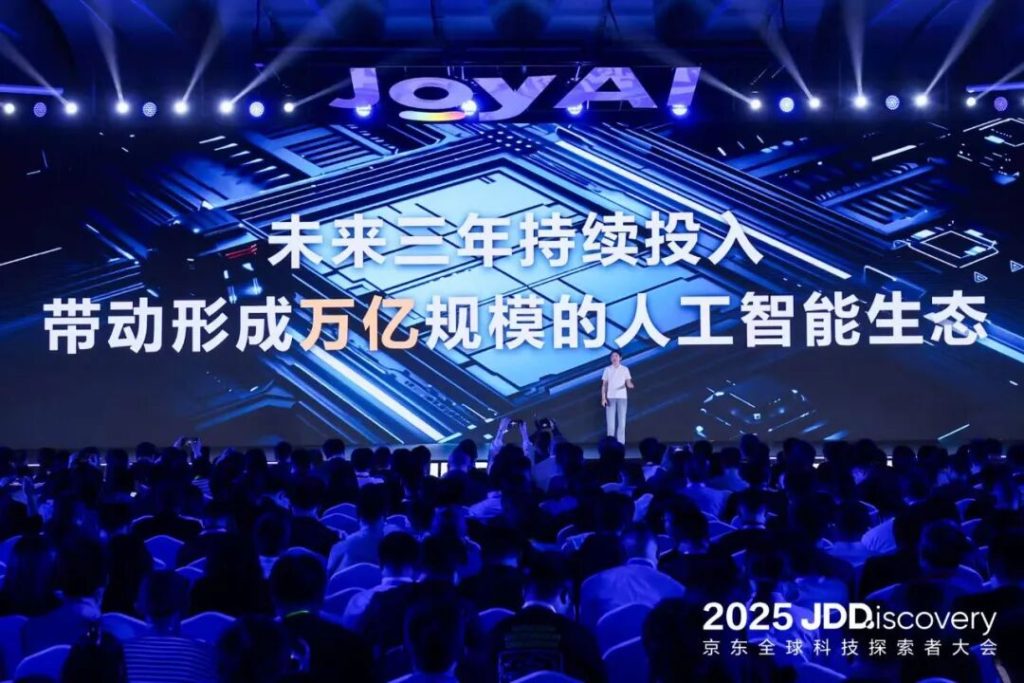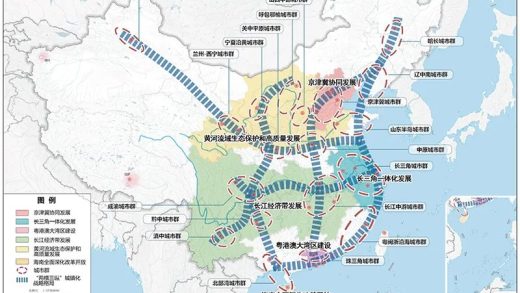
Read More《AI重构供应链,京东剑指万亿人工智能生态》
Positive Reviews: Scenario-driven + Open Ecosystem, JD Provides a “Practical Sample” for the Implementation of Industrial AI
In the crucial stage when the AI industry is shifting from the “parameter competition” to “value verification,” JD’s comprehensive display at the JDD Conference offers a replicable “practical methodology” for the in – depth application of industrial AI. Its core logic – “refining capabilities through scenario – driven approaches and releasing value via an open ecosystem” – not only meets the current industry’s urgent need for the ROI of AI applications but also proves the feasibility of the deep integration of AI and the real economy through the verification of the entire supply – chain link.
Firstly, JD’s “scenario – driven” strategy addresses the core pain points of AI implementation. Different from some enterprises that regard AI as an independent technology module, JD embedded AI into its most complex supply – chain scenarios from the very beginning. The selection of the four major scenarios of logistics, industry, health, and retail shows great strategic vision: The logistics scenario, with multiple links, a large amount of data, and a fast feedback loop, is a natural training ground for AI reinforcement learning; The industrial scenario involves 57.1 million SKUs and more than 40 sub – industries, posing high requirements for the generalization ability and vertical depth of the model; The health scenario requires “trustworthiness” as the bottom line, forcing the technology to upgrade towards evidence – based medicine and multi – modal integration; The retail scenario is directly related to the actual experiences of users and merchants, verifying whether AI can truly improve transaction efficiency and trust.
This “self – utilization and refinement” path endows JD’s AI capabilities with “practical genes.” For example, through global perception, model evolution, and human – machine collaboration, Logistics Superbrain 2.0 transforms the operation process that originally relied on manual experience into data – driven decision – making. The achievements of a 15% increase in operation standardization and a 20% increase in front – line efficiency represent a qualitative leap that traditional automation tools cannot achieve; The industrial large – scale model JoyIndustrial not only optimizes procurement and fulfillment processes but also compresses the processing time of hundreds of thousands of governance tasks from “months” to “hours” through more than 40 types of intelligent agents such as commodity governance and supply – demand matching, solving the long – standing efficiency bottleneck in the industrial supply chain; The medical large – scale model Jingyi Qianxun 2.0 introduces evidence – based medical evidence and establishes a cross – modal “thinking chain,” setting a “trustworthy benchmark” for AI applications in sensitive fields. These achievements prove that AI can only be truly transformed into quantifiable value through “trials and tribulations” in real business scenarios.
Secondly, JD’s “open ecosystem” strategy accelerates the industry penetration of AI capabilities. From the three major AI products (Jingxi, “TataTa” digital human, JoyInside 2.0) to the three in – depth application platforms (JoyAgent 3.0, JoyCode 2.0, Digital Human 4.0), JD not only productizes the capabilities refined through self – utilization but also lowers the threshold for industry applications through open – source. For example, as the industry’s first 100% open – source enterprise – level intelligent agent, JoyAgent 3.0 integrates multi – modal RAG, data governance, and other capabilities, supporting enterprises to seamlessly connect with their own knowledge bases; JoyCode 2.0 enables “zero – handwritten code” programming, opening up JD’s internal R & D efficiency – improvement experience to external developers; Digital Human 4.0 surpasses human anchors at one – tenth of the cost, becoming a long – term digital asset for brands. This “capability output + tool empowerment” model allows small and medium – sized enterprises to quickly access mature AI solutions without repeated investment in underlying R & D, directly promoting the leap of AI from “enterprise self – use” to “industry – wide sharing.”
More notably, JD’s AI strategy always builds a moat around “trust.” In the medical scenario, Jingyi Qianxun 2.0 ensures the credibility of diagnosis and treatment through evidence – based medical evidence; In the retail scenario, AI shopping and AI fitting enhance users’ confidence in decision – making through personalized recommendations and real – life fitting effects; In the industrial scenario, JoyIndustrial improves the credibility of the supply chain through standardized governance and compliance assessment. This “trust – first” logic not only addresses the pain point of “reliable technology but users’ reluctance to use” in AI applications but also transforms JD’s supply – chain advantages into new competitiveness in the AI era – when users and enterprises choose JD’s AI products, they are essentially choosing a “trustworthy system” verified in real – world supply – chain scenarios.
Negative Reviews: Scenario Dependence, Ecosystem Risks, and Compliance Challenges – JD’s AI Strategy Needs to Break Through Three Boundaries
Although JD’s AI practice provides valuable experience for the industry, there are still potential risks and limitations in the process of its strategy implementation. It is necessary to be vigilant that the “scenario advantage” may turn into “path dependence,” the “open ecosystem” may hide “collaboration pitfalls,” and the “trustworthy commitment” may face “implementation tests.”
Firstly, the “depth” of scenario – driven approaches may limit the “breadth” of AI capabilities. JD’s AI capabilities highly depend on the complexity and data volume of its own supply – chain scenarios. For example, the optimization of Logistics Superbrain 2.0 is based on JD’s unique self – built logistics network structure, the training of the industrial large – scale model JoyIndustrial relies on the exclusive data of 57.1 million SKUs, and the medical large – scale model is bound to JD Health’s diagnosis and treatment scenarios. This “scenario customization” makes JD’s AI outstanding in vertical fields but may also lead to “acclimatization” when exporting externally. For instance, the supply – chain scale of small and medium – sized enterprises is much smaller than that of JD, and the data quality and feedback loop speed may not support model iteration; In the industrial field, the SKU characteristics of different sub – industries vary greatly, and whether the generalization ability of JoyIndustrial can cover more industries still needs to be verified; In the medical scenario, the diagnosis and treatment processes and data standards of different hospitals vary, and the “cross – institutional adaptability” of Jingyi Qianxun 2.0 may become a bottleneck for promotion. If JD cannot balance “scenario customization” and “industry – wide applicability,” the expansion speed of its AI ecosystem may be restricted.
Secondly, the “collaboration cost” of the open ecosystem may affect the implementation efficiency of the strategy. JD has set the goal of “driving an artificial – intelligence ecosystem worth trillions of yuan,” which requires the participation of a large number of partners (such as robot manufacturers, small and medium – sized enterprises, and developers). However, the complexity of ecosystem coordination cannot be underestimated. For example, as the “brain” of the hardware ecosystem, JoyInside 2.0 needs to be deeply coordinated with the hardware designs of partners such as Unitree and Fuzozo. If there are differences in technical standards and data interfaces between the two sides, the product experience may vary; After the open – source of JoyAgent 3.0, the quality of contributions from community developers is difficult to standardize, which may affect enterprise users’ trust in the platform’s reliability; The promotion of Digital Human 4.0 in scenarios such as marketing and cultural tourism requires the distribution of interests among brand owners, content providers, and technology providers. If the interest mechanism is not designed reasonably, the enthusiasm of ecosystem participants may decline. In addition, although the open – source strategy can accelerate technology diffusion, it may also allow competitors to quickly copy JD’s AI capabilities, weakening its first – mover advantage – when the industry generally masters similar intelligent – agent development tools, JD’s “differentiated barriers” will face challenges.
Finally, the “compliance risks” in sensitive scenarios may impact the “trustworthy” brand image. JD emphasizes “trustworthiness” in scenarios such as medical care, industrial cross – border operations, but the compliance of AI applications is dynamic and complex. For example, although Jingyi Qianxun 2.0 introduces evidence – based medical evidence, does its diagnosis and treatment suggestions comply with the latest clinical guidelines? If misdiagnosis occurs due to untimely model updates, the liability determination will face legal disputes; In the industrial scenario, when the customs – clearance agent intelligent agent handles cross – border compliance, if the evaluation deviation occurs due to policy differences between different countries, it may bring legal risks to enterprises; In the retail scenario, if the personalized recommendations of AI shopping overly rely on user data, it may lead to privacy – leakage problems. Although JD emphasizes “trust first,” minor errors in technology implementation may be magnified into brand crises. For example, in 2023, a medical AI caused diagnosis deviations due to data – annotation errors, which triggered collective complaints from patients. Similar risks may also occur in the application of JD’s medical large – scale model. How to find a balance between “efficiency improvement” and “compliance security” is a topic that JD’s AI strategy must continuously invest in.
Advice for Entrepreneurs: Extract the “Scenario – Data – Ecosystem” Triangle Rule from JD’s Practice
JD’s AI strategy provides valuable references for entrepreneurs. Combining its core logic of “scenario – driven, data – closed – loop, and open – ecosystem,” entrepreneurs can optimize their own AI layout from the following three aspects:
Focus on Core Scenarios, First “Deeply Verify” and then “Broadly Expand”
Entrepreneurs should avoid blindly pursuing large – model parameters or technological ostentation. Instead, they should choose the most complex, high – frequency, and value – generating scenarios in their own businesses as the entry points for AI. For example, e – commerce entrepreneurs can first refine their AI capabilities in scenarios such as “fulfillment scheduling” or “return – rate optimization,” and education entrepreneurs can focus on the scenario of “personalized learning – path recommendation.” Through the in – depth verification of core scenarios (such as the efficiency – improvement data of JD Logistics Superbrain 2.0), entrepreneurs can not only build technical confidence but also prove the actual ROI of AI to investors and users, laying a foundation for subsequent expansion into other scenarios.Build a Data Closed – Loop and Let AI “Evolve in Feedback”
The robustness of JD’s AI capabilities lies in the high – frequency and real “data – feedback closed – loop” provided by its supply – chain scenarios (such as real – time logistics operation data and dynamic changes in industrial supply and demand). Entrepreneurs need to attach importance to the “collection – analysis – iteration” mechanism of data: On the one hand, accumulate high – quality vertical data through business scenarios (for example, medical entrepreneurs need to obtain real diagnosis and treatment case data rather than general medical literature); On the other hand, establish a fast – feedback channel (such as users’ click/purchase behavior for AI recommendations and merchants’ adoption rate of intelligent – agent suggestions) to continuously optimize the model in actual use. It should be noted that the data closed – loop needs to comply with privacy – protection regulations (such as GDPR and the “Personal Information Protection Law”) to avoid being hindered by data – compliance issues.Open but with Boundaries, and Ensure “Value Alignment” in Ecosystem Cooperation
Entrepreneurs can learn from JD’s “open – platform” concept but need to clarify their core capabilities and the “tool layer” that can be opened up. For example, if the core capability is an “industrial quality – inspection AI model,” data – annotation tools or inference engines can be opened up instead of directly outputting model parameters; If focusing on “retail AI recommendation,” the user – behavior analysis platform can be opened up to help merchants optimize product selection. In ecosystem cooperation, entrepreneurs should preferentially choose partners that are highly compatible with their own business scenarios (such as JD’s selection of robot manufacturers like Unitree) to ensure consistency in technical standards, target users, and interest distribution, avoiding the dispersion of core resources due to “ecosystem expansion.”Prioritize “Trustworthiness” in Sensitive Scenarios and Balance Technology Investment and Compliance Costs
If involved in sensitive scenarios such as medical care, finance, and cross – border operations, entrepreneurs need to take “trustworthiness” as the core indicator of technology R & D. For example, medical AI needs to be verified by third – party medical institutions to ensure that diagnosis and treatment suggestions comply with clinical guidelines; Financial AI needs to pass regulatory sandbox tests to prove the accuracy of risk assessment; Cross – border compliance AI needs to establish a multi – regional policy database and regularly update model rules. At the same time, compliance costs (such as legal teams and data – security audits) need to be reserved to avoid legal disputes caused by technical loopholes or policy changes.
In summary, JD’s AI practice proves that the value of AI does not lie in the size of parameters or the complexity of technology but in its ability to solve specific problems in real scenarios and amplify this value through an open ecosystem. Entrepreneurs need to take “scenarios as the root, data as the soul, and the ecosystem as the wings.” While deeply cultivating their own businesses, they should connect with external resources with an open mind to gain an edge in the competition in the AI era.




